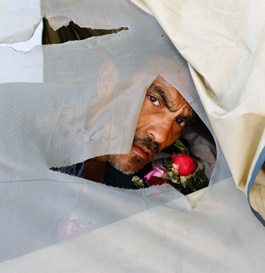home | north bay bohemian index | the arts | visual arts | review

Photograph by Sylvia Steininger
WITHOUT A HOME: A chalice is implied in both the tent and flower of Sylvia Steininger's untitled photograph.
Chalice of Fine Arts
'The Chalice Project' reinterprets a simple, multilayered word
By Jessica Dur
"What does the word 'chalice' mean to you?"
This is the question that was posed to local artists six months ago, and their answers, using acrylic, glass, mosaic, fabric, colored pencil, photography, tree branches and even cut-up cat-food tins, will be unveiled to the public in an opening reception at the Glaser Center on Saturday, Jan. 15.
For many, the word "chalice" conjures the famous and sought-after Holy Grail, the goblet from which Jesus is said to have drunk at the Last Supper. For others, the chalice represents the sacred feminine, a notion buffered by Riane Eisler's 1987 groundbreaking book The Chalice and the Blade. "Chalice" can also refer to the cup-shaped interior of a flower, and a type of coral. Female artists and the female form are well represented in this juried art exhibition, but with some 40 artists featuring their unique interpretations of "chalice," the cup of varied ideas literally runneth over.
In a nod to the Unitarian Universalists, Nancy Wilkins' Spirit of Life depicts their symbol of the flaming chalice in watercolor and collage. Upon learning of the project, nurse and sometime 3-D artist Susan Bartholome felt inspired to fuse glass; she creates a light-catching chalice that might not hold wine, but will capture the eye. On a less literal level, pediatrician Jean Smith uses a plastic swimsuit display torso from Costco as the base for her dramatic Wounded Mother. The earth is presented as an injured (and bandaged) chalice resting atop a branch and a stone.
The Chalice Project culminates in a gala party and silent auction at the Glaser Center on Saturday, Feb. 26, and in a gesture befitting its meaning will offer a portion of the proceeds to COTS, the Committee on the Shelterless.
Several artists capture the idea of the chalice as home. For Johanna Regan-Ottenweller, the project challenged her to be more innovative. "For the first time, I sawed a cup in half and used it in a way I never had before," she says. Regan-Ottenweller, who runs the Jenner Mosaic Workshop, constructs the cheerful mosaic fountain Homes for All as an antidote to the depressing problem of homelessness, whereas wedding photographer Sylvia Steininger, who enjoys turning her lens to the "darker side of life," makes a statement with her untitled photograph of a homeless man with a red flower peering out of a hole in his tent (above). For her, "chalice" is both the shelter of the tent and the unseen female who inspired the unexpected sanguine blossom.
"There is a huge rebel inside of me," says Steininger of her photo. "Why must everything have a name? Naming indicates what you should think about my piece; I'd rather people interpret it for themselves." In Marsha Connell's collage series Dream Vessels, the chalice is a nest which gives rise to eggs and pens symbolic of the potential for transformation.
Whatever one's interpretation of this layered and often loaded noun, chairperson Nancy Hargas says that the Chalice Project "captures the imagination and stirs the juices." She invites attendees to "expand [their] horizons and awaken to the mystery of the chalice."
Drink and be filled by the Chalice Project, on display from Jan. 15–Feb. 25 at the Glaser Center. 547 Mendocino Ave., Santa Rosa. Opening reception Jan. 15; 5:30pm. 707.568.5381.
Send a letter to the editor about this story.
|
|
|
|
|
|